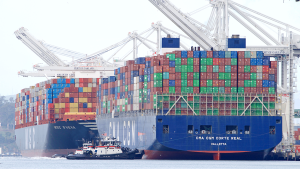If all claims made were to be believed about how mass timber construction (MTC) can reduce the carbons and GHGs created by the construction industry, no further discussion would be needed.
Enthusiasts speak of the multiple benefits of MTC beyond mere carbon capture: offsite manufacturing, faster onsite assembly with less noise and greater tolerances to temperatures. They also claim MTC is stronger and lighter than steel, and perhaps as fireproof.
However, the cement industry will hear none of it.
“They weave a great tale,” Michael McSweeney, president and CEO of the Cement Association of Canada (CAC), told the Daily Commercial News.
At the top of McSweeney’s list of counter-arguments is the amount of carbon and GHGs created by the forestry industry itself. He says that of the 200 million tons of GHGs created each year in British Columbia’s forests, 30 million are directly related to forest harvesting activity. The rest are due to fires.
“For example, when they take a tree from the forest in B.C., they strip all the branches and leaves and leave them on the ground,” he explains. “They either burn that or allow it to decompose. That alone is responsible for four million tons of GHGs each year.”
He contrasts that with the one million tons emitted annually by the province’s entire cement industry.
McSweeney also takes issue with claims that MTC components manufactured from foreign trees deliver significant environmental benefits.
“If you listen to the wood industry, they would have you believe that every ounce of carbon that has been sequestered in that tree stays in that tree. It’s just not true.”McSweeney says trees harvested in Scandinavia, for example, lose 25 per cent of the carbon benefits just due to transportation.
“When you cut down a tree and turn it into whatever product, at the end of the day the carbon sequestered in that tree is only 15 per cent of the carbon the tree sequestered over its lifetime. Eight five per cent is released.”
Much of what McSweeney says is backed by research undertaken by a scientific community attempting to address many unanswered questions surrounding the Life Cycle Assessments (LCA) of mass timber.
The International Institute for Sustainable Development (IISD) conducted a study two years ago, commissioned by the CAC, under the guidance of what the IISD describes as, “university affiliated academics, notable environmental organizations and architects/designers from the green building community.”
Overall, the study found several built-in errors in Canada’s GHG tracking of buildings.
Among the key findings was, “carbon losses related to soil disturbance in logging operations, variable regeneration rates of forests, and conversion of primary to secondary forests are not counted. This may represent up to 70 per cent of total lifecycle emissions. These impacts challenge the prevailing assumption wood construction materials are less carbon intensive than steel or concrete and should be favoured.”
That’s a stunning statement, but one supported by John Talberth, president and founder of the Center for Sustainable Economy, based near Portland, Ore.
“The notion that it is better to store carbon in wood products rather than forests is absurd,” Talberth writes in The Hill. “Wood products don’t store carbon — they release it. Any storage is temporary.”
At the same time, the concrete industry has taken important strides towards reducing the carbon and GHGs associated with its product. Carbon capture manufacturing processes and energy reduction investments made at plants around the world are numerous and significant.
McSweeney admits a day may come when MTC might become a better building product. Meanwhile, bringing wood to Toronto construction sites from faraway places makes little sense to him in terms of sustainability.
He advocates, “The 100 km construction diet” as an alternative.
“We have local concrete, steel in Hamilton and Oshawa. Get your construction materials from close to home.”
John Bleasby is a Coldwater, Ont.-based freelance writer. Send comments and Inside Innovation column ideas to editor@dailycommercialnews.com.










Let me first say that I am biased and favour wood use in construction, but appreciate any criticism that may provide better understanding of mass timber or forest management and advance us all toward more sustainable building practises.
I will start with the first criticism that leaving or burning slash piles count as GHG emissions in forestry. If those are to be counted as part of a forest harvesting operation, they ought to also be counted as part of the natural process of the forest. A process that also occurs more frequently with increasing age of the forest (see stand dynamics). Trees fall down, die, decompose, and burn – granted not in the same short interval that would occur during a harvest – especially a clearcut. Further, removing the slash from the site removes nutrients and coarse woody debris as habitat for species that will return to the clearcut. In Ontario, slash is often redistributed throughout the harvested area, left where the tree was harvested, or used as biomass. There are many potential uses for slash, one of which includes biomass electricity or heat generation – though a source of emissions, it is an anthropocentric use of otherwise ‘wasted’ material.
The second criticism is the amount of carbon stored in the product the tree was made from. I would like to know if the 85% number that is claimed to be released refers to the relative amount of GHG’s released in the production and transportation of that product, or the consideration of the total carbon biomass of a standing tree when compared to, say, a single 2×4. I don’t disagree that there is an awful lot of emissions involved in the harvest and transportation of forest products, which is why I am excited for industrial electric harvesting equipment and haul trucks.
The third one I believe is the least effective criticism. That the GHG emissions of soil disturbance, regeneration, and primary (I assume this mean old-growth) to secondary forests are not counted in claims that mass timber is sustainable. I wouldn’t entirely disagree with this statement but it feels a bit like the pot calling the kettle black. I’m unsure if the deforestation (change from forest to non forest land) and permanent negative changes to the landscape (soil profile, water table, habitat) associated with aggregate mining are included in the GHG emissions associated with the aggregate industry. If they are included in the 1M tons of emissions for the cement industry, I will commend that, and suggest that those be taken into account for other industries as well as the development of previously naturalized landscapes.
Finally, the claim that the storage is temporary seems simultaneously untrue, a benefit if true, and hypocritical. Untrue because there are wood structures still standing from hundreds of years ago, a benefit because human constructs arguably should not be built to be permanent (or impossible to dismantle) and hypocritical because everyone knows concrete doesn’t last forever either.
His closing statement we can absolutely agree upon – get your construction materials from close to home. Though I wonder if that includes the iron and other alloy components for the steel ‘made’ in Hamilton…